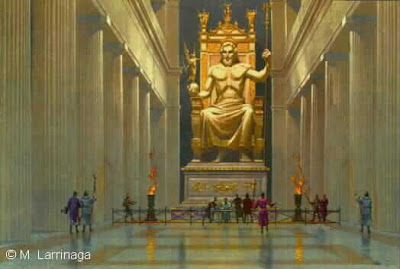 The Statue of Zeus at Olympia Photo
The Statue of Zeus at Olympia Photo The Statue of Zeus Olympia Photo
The Statue of Zeus Olympia Photo The Statue of Zeus at Olympia
The Statue of Zeus at Olympia The Statue of Zeus at Olympia Photo
The Statue of Zeus at Olympia PhotoThis is the statue of the god in whose honor the Ancient Olympic games were held. It was located on the land that gave its very name to the Olympics. At the time of the games, wars stopped, and athletes came from Asia Minor, Syria, Egypt, and Sicily to celebrate the Olympics and to worship their king of gods: Zeus.
 The Statue of Zeus at Olympia
The Statue of Zeus at OlympiaIn the ancient world, there were many temples dedicated to Zeus, the king of the Greek gods. But, there was only one temple to Zeus that housed one of the seven wonders of the ancient world. The Temple of Zeus at Olympia was home to one of greatest sculptural achievements of ancient history. The Statue of Zeus at Olympia represented the pinnacle of Classical sculptural design, as well as showcased the engineering that was required to construct such a massive chunk of marble and gold.
The city-state of Olympia was a center of religious worship, and was also the birthplace of the Olympic games. Believed to have begun in 776 B.C., the Olympic games demonstrated the physical prowess as well as the political strength of the participating Greek poleis. The Olympic games were considered to be a part of religious rituals that revolved around the king of the Greek gods, Zeus. So it was only fitting that a grand temple and an even grander cult representation were constructed for the many Greeks who made pilgrimages there in order to worship their father god.
The temple of Zeus was built between 466 - 456 B.C., during the height of Classical Greek architecture and artistic endeavors. It was designed by Libon, an architect from neighboring Elis. The temple was constructed of local shell stone in the Doric style, the predominant architectural style of the time, and the same style as the Parthenon in Athens. The temple itself acted merely as a protective home for the real showpiece, the cult statue of Zeus himself.
The renowned Greek sculptor Pheidias brought Zeus to life with his creation around 435 B.C. After creating the cult statue of Athena for the Parthenon, Pheidias left Athens in shame as a result of a political scandal and an erroneous embezzlement charge. He immediately came to Olympia to begin work on Zeus.
Pheidias had developed a technique that allowed his enormous creations of ivory and precious metals to be formed without crumbling under their own weight. Beginning with a wooden frame built on site, he would lay thin plates of ivory soaked in a liquid to make them moldable, and place them upon the mold along with sheets of gold (for Zeus draping clothing). The pieces matched up perfectly, and the joints were nearly invisible.
The appearance of the statue must have been imposing, impressive, and awe-inspiring. The seated statue was over 40 feet tall. Zeus' throne was just as impressive, constructed of cedar and inlaid with ivory, gold, and ebony. He held a statue of Nike, the Greek goddess of victory, in his left hand, and a staff with an eagle perched atop it in his right hand.
The statue inspired reverence for over 800 years in its temple home in Olympia. Kings and even Roman Emperors who gazed upon it were known to cry in veneration. In fact, the Roman Emperor Caligula even tried to have the statue taken for himself in the late 30's A.D., with no success. In the 450's A.D., it was taken from the temple to Constantinople, where it sat in a palace. The palace was destroyed by fire in 462 A.D., and one of the seven wonders of the ancient world was unfortunately lost forever.
No comments:
Post a Comment